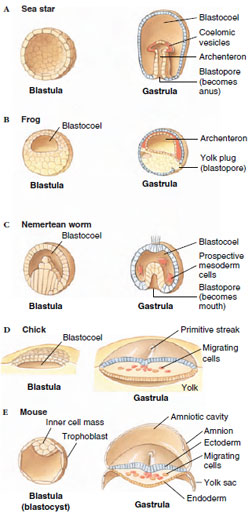Blastulation
Blastulation
Cleavage, however modified by different
cleavage patterns and by the presence
of varying amounts of yolk,
results in a cluster of cells called a blastula (commonly called a blastocyst
in mammals) (Figure 8-11). In
many animals the cells arrange themselves
around a central fluid-filled
cavity called the blastocoel. At this
point, the embryo consists of a few
hundred to several thousand cells
poised for further development. There
has been a great increase in total DNA
content, since each of the many
daughter cell nuclei, by chromosomal
replication at mitosis, contains as much
DNA as the original zygote nucleus.
The whole embryo, however, has not
increased in size above the zygote; it
has been subdivided into smaller and
smaller cells.
 |
| Figure 8-11 Blastula and gastrula stages in embryos ofsea star, frog, nemertean worm, chick, and mouse. |




